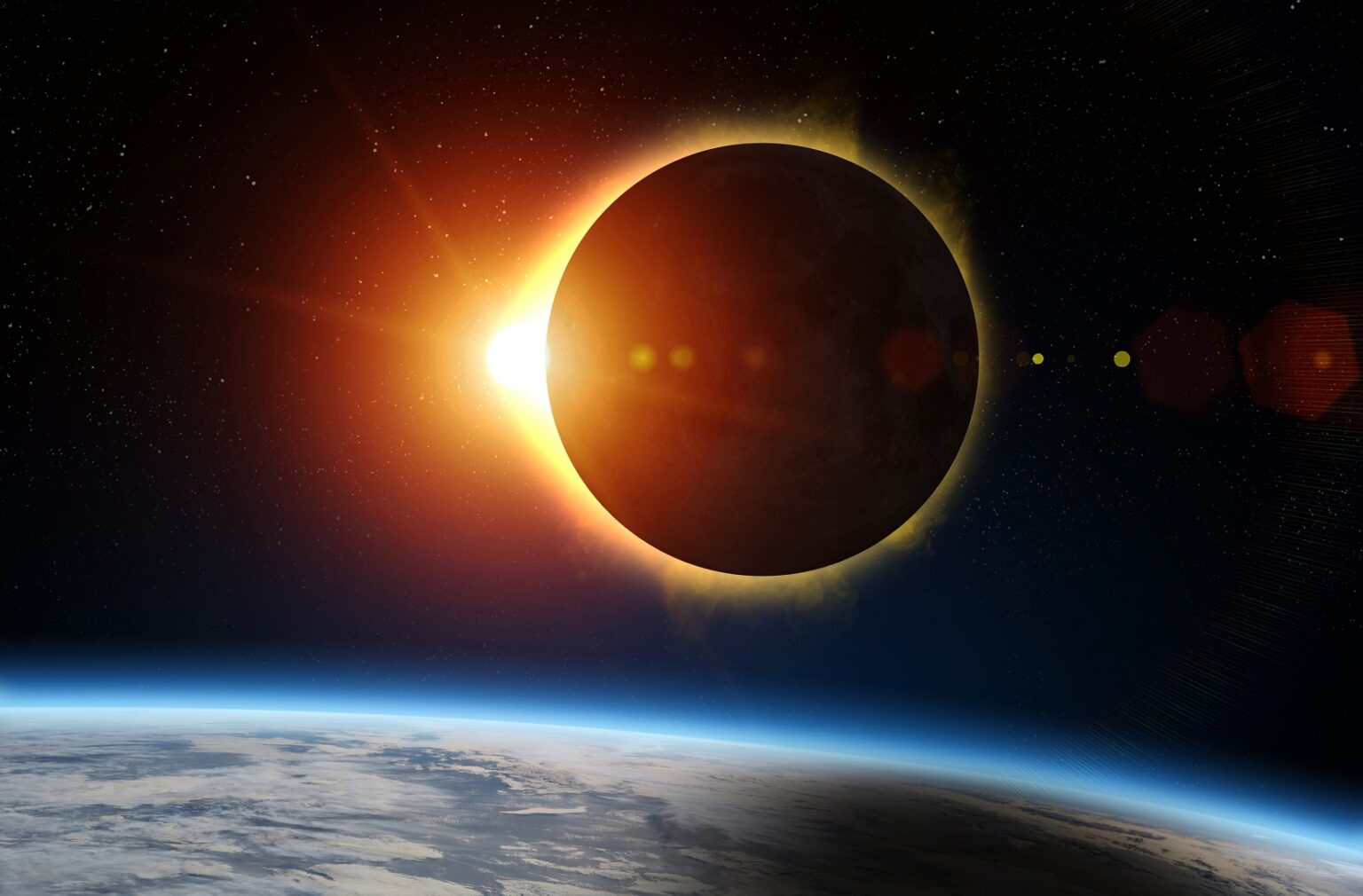
By Staff Middle Land
By John Uri
Johnson Space Center
On April 8, 2024, North America will witness its last total solar eclipse for more than twenty years. Other parts of the world will experience the rare celestial event in the coming decade. A total solar eclipse occurs when the Moon passes directly between the Sun and the Earth, blocking its disk from view but making its corona visible in a dazzling display. Although spectacular when seen from the ground, observed from space, solar eclipses appear as large shadows moving across the face of the Earth. The unique geometry of the Earth-Sun-Moon system allows total solar eclipses to occur. Eclipses also occur outside the Earth-Moon system, although the geometries of those worlds rarely if ever produce the stunning display visible on Earth. Spacecraft exploring other worlds have documented these extraterrestrial eclipses.
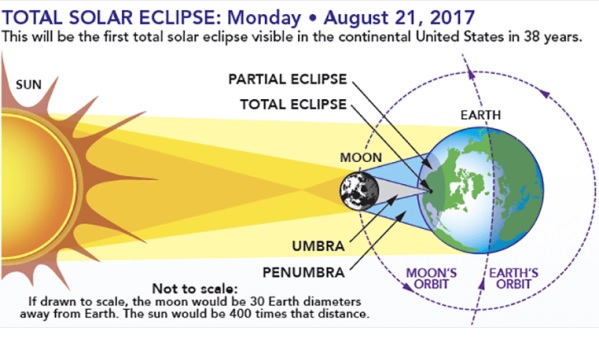
A solar eclipse occurs when the Moon passes between the Sun and the Earth, with the Moon casting its shadow on its home planet. Although the Sun is much larger than the Moon, it is also much farther away. As seen from Earth, the Sun and Moon have roughly the same angular diameter and appear roughly the same size in the sky. A total eclipse occurs when the Moon blocks out the Sun’s disk entirely. Because the Moon does not orbit in a perfect circle around the Earth, it appears smaller at its farthest point thus creating annular eclipses. Moons around other planets can also create eclipses although their different sizes relative to the Sun do not create our familiar eclipses. Planets with multiple moons can have more than one eclipse occur at the same time.
Gemini XII astronauts James A. Lovell and Edwin E. “Buzz” Aldrin for the first time photographed a solar eclipse from Earth orbit on Nov. 12, 1966. Sixteen hours into their flight, the nearly total eclipse came into view as they flew over the Galapagos Islands and Aldrin took several photographs and a short film clip. Calculations showed that Gemini XII passed within 3.4 miles of the center of the eclipse’s path that traversed South America. The Surveyor 3 spacecraft observed the first solar eclipse from the Moon on April 24, 1967. Unlike solar eclipses observed on Earth, this time the Earth itself blocked the Sun – observers on Earth saw the event as a lunar eclipse as the Moon passed through the Earth’s shadow. In November 1969, as Apollo 12 astronauts Charles “Pete” Conrad, Richard F. Gordon, and Alan L. Bean neared Earth on their return from the second lunar landing – during which they visited Surveyor 3 – orbital mechanics had a show in store for them. Their trajectory passed through Earth’s shadow, treating them to a total solar eclipse. From their perspective, the Earth appeared about 15 times larger than the Sun. Gordon radioed Mission Control, “We’re getting a spectacular view at eclipse,” and Bean proclaimed it a “fantastic sight.” Conrad reported on the rapidly changing scenery, with the Sun illuminating the Earth’s atmosphere in a 360-degree ring with ever-changing colors while the planet remained pitch black. In the darkness, they could see flashes of lightning in thunderstorms appearing as fireflies. As their eyes adapted to the dark portion of the Earth, they saw landmasses such as India and even city lights. In the center of the Earth’s dark disc they reported seeing a large bright circle that turned out to be the glint of the full Moon reflecting off the Indian Ocean.
The credit belongs to French astronaut Jean-Pierre Haigneré for taking the first photograph from Earth orbit of the Moon’s shadow during a solar eclipse. He photographed the Aug. 11, 1999, total eclipse pass over England while onboard the Russian space station Mir as an Expedition 27 flight engineer. NASA astronaut Donald R. Pettit claims the title as the first person to photograph an eclipse from the International Space Station when he observed the Dec. 2, 2002, total eclipse during Expedition 6. As an additional claim, on May 20, 2012, Pettit observed his second eclipse from the space station during Expedition 31, this one an annular eclipse over the Western Pacific Ocean.
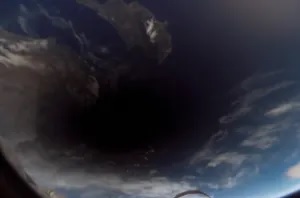
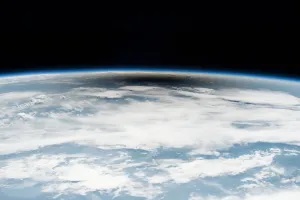
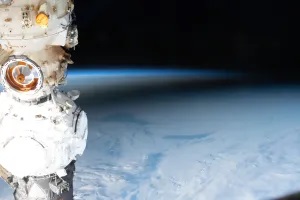
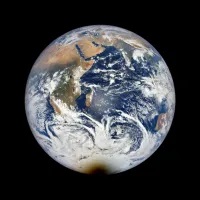
Space station crews have observed and documented a number of solar eclipses in addition to Pettit’s two sightings, their ability to see the Moon’s shadow as it traverses the Earth’s surface determined by their orbital trajectory. Expedition 12 observed the total eclipse on March 29, 2006, Expedition 43 documented the total eclipse on March 25, 2015, Expedition 52 observed the most recent total eclipse visible from North America on Aug. 21, 2017, Expedition 61 observed the annular eclipse on Dec. 26, 2019, Expedition 63 saw the annular eclipse on June 21, 2020, Expedition 66 imaged the total eclipse over Antarctica on Dec. 4, 2021, and Expedition 70 viewed the annular eclipse visible in North America on Oct. 14, 2023. Positioned nearly one million miles away at the L1 Earth-Sun Lagrange point, the National Oceanic and Atmospheric Administration’s Deep Space Climate Observatory (DSCOVR) satellite keeps a watchful eye on Earth’s climate. NASA’s Earth Polychromatic Imaging Camera (EPIC), a camera and telescope aboard DSCOVR, has taken stunning images of the Moon’s shadow during eclipses as well as the Moon transiting across the face of the Earth.
Mars
Beyond the Earth-Moon system, eclipses do not occur on Mercury and Venus since they lack natural satellites to block out the Sun. Mars has two small satellites, Phobos and Deimos, both too small to fully eclipse the Sun, even though it appears only half as big as on Earth. Several rovers have captured Phobos and Deimos as they form annular eclipses. Some astronomers contend that due to the small sizes of the Martian satellites, especially Deimos, compared to the Sun, these are technically transits, not eclipses, but no formal definition exists. The Mars Exploration Rover Opportunity imaged the first eclipses from the surface of Mars shortly after its arrival on the planet, first of Deimos on March 4, 2004, followed by Phobos three days later. More recently, the Mars 2020 Perseverance rover imaged the annular eclipse of Phobos on April 20, 2022, and the eclipse (or transit) of Deimos on Jan. 22, 2024.}
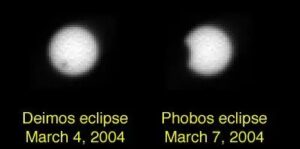
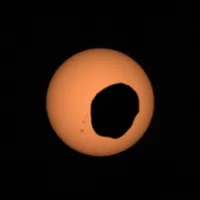
Jupiter
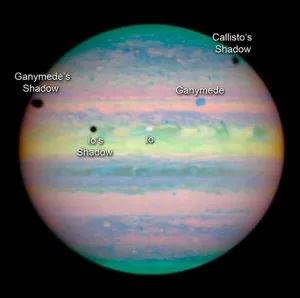
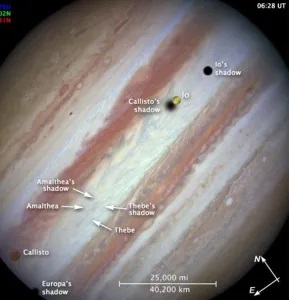
Since the outer gas giant planets do not have solid surfaces, no spacecraft has imaged an actual eclipse by one of the multitude of moons orbiting these worlds. What we can observe, through ground-based and orbiting telescopes and spacecraft are the shadows cast by the moons on their home planets. Eclipses on Jupiter are not exceptionally rare given the planet’s large size compared to its many moons and greater distance from the Sun. Only five of Jupiter’s moons, Amalthea, Io, Europe, Ganymede, and Callisto are either large enough or close enough to the planet to completely occult the Sun. And given the low tilts of the moons’ orbits, they cast a shadow on every revolution. Double, triple and multiple simultaneous eclipses are not uncommon. The Hubble Space Telescope has observed numerous such events. Given the number of Jupiter’s moons, especially the four large Galilean moons, and that their orbits all lie very close to Jupiter’s equatorial plane, they occasionally eclipse each other, with the outer moons passing between the Sun and the inner moons. When Earth passes through Jupiter’s equatorial plane, fortunate observers can capture these rare events using ground-based telescopes, sometimes accidentally as they observe the Galilean moons for other reasons.
Since the outer gas giant planets do not have solid surfaces, no spacecraft has imaged an actual eclipse by one of the multitude of moons orbiting these worlds. What we can observe, through ground-based and orbiting telescopes and spacecraft are the shadows cast by the moons on their home planets. Eclipses on Jupiter are not exceptionally rare given the planet’s large size compared to its many moons and greater distance from the Sun. Only five of Jupiter’s moons, Amalthea, Io, Europe, Ganymede, and Callisto are either large enough or close enough to the planet to completely occult the Sun. And given the low tilts of the moons’ orbits, they cast a shadow on every revolution. Double, triple and multiple simultaneous eclipses are not uncommon. The Hubble Space Telescope has observed numerous such events. Given the number of Jupiter’s moons, especially the four large Galilean moons, and that their orbits all lie very close to Jupiter’s equatorial plane, they occasionally eclipse each other, with the outer moons passing between the Sun and the inner moons. When Earth passes through Jupiter’s equatorial plane, fortunate observers can capture these rare events using ground-based telescopes, sometimes accidentally as they observe the Galilean moons for other reasons.
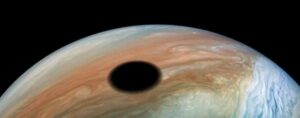
The Juno spacecraft, in orbit around Jupiter since 2016, has returned stunning images of Jupiter’s cloud patterns. On Sept. 11, 2019, it captured a spectacular image of Io’s shadow on Jupiter’s colorful cloud tops. On Feb. 25, 2022, Juno imaged the largest moon Ganymede’s shadow.
Saturn and beyond
Like Jupiter, dozens of moons orbit around the ringed planet Saturn, providing ample opportunities for telescopes and spacecraft to observe them passing in front of and casting their shadows onto the planet. The Cassini spacecraft, in orbit around Saturn between 2004 and 2017, captured thousands of images of the planet, its rings, and its moons. On many occasions, Cassini passed behind the planet and its moons, creating artificial eclipses, while at other times the spacecraft imaged the moons’ shadows on the planet’s cloud tops. The Hubble Space Telescope captured a series of images of a rare quadruple eclipse on Feb. 24, 2009, as Saturn’s moons Enceladus, Dione, Titan, and Mimas transited across the planet, casting their shadows on the cloud tops.
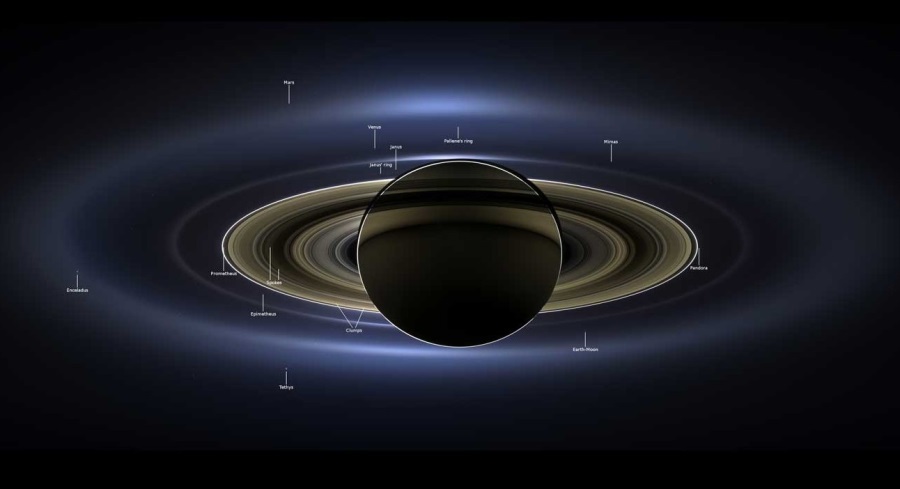
On July 19, 2013, Cassini took a series of images from a distance of about 750,000 miles as Saturn eclipsed the Sun. In the event dubbed The Day the Earth Smiled, people on Earth received notification in advance that Cassini would be taking their picture from 900 million miles away, and were encouraged to smile at its camera. In addition to the Earth and Moon, Cassini captured Venus, Mars, and seven of Saturn’s satellites in the photograph.
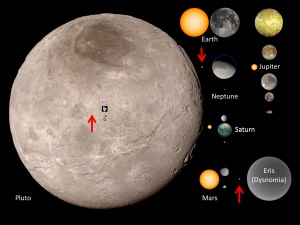
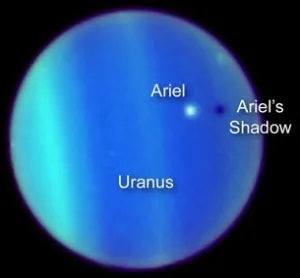
The Earth occupies a unique position with the nearly equal apparent diameters of the Moon and the Sun, providing opportunities for annular and total solar eclipses. As viewed from planets farther in the solar system, the Sun’s apparent diameter diminishes, with the apparent sizes of the moons orbiting those planets either larger or smaller than the Sun. Eclipses as we know them do not exist elsewhere in the solar system. Spacecraft exploring those remote worlds easily create artificial eclipses by passing through the planets’ shadows, often revealing important information, such as New Horizons imaging the tenuous atmosphere surrounding Pluto.
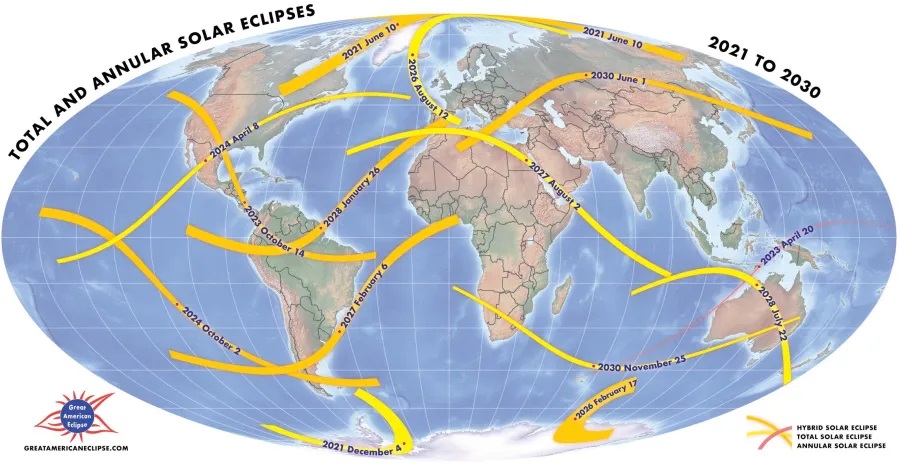
The next total solar eclipse visible in North America will not occur until 2044, but over the next few years, several eclipses visible in other parts of the world will no doubt be targets of opportunity for astronauts’ cameras aboard the space station. And spacecraft exploring planets in the solar system will continue to document eclipses in those faraway places.
Original article: NASA









Cancel anytime


Using our website
You may use the The Middle Land website subject to the Terms and Conditions set out on this page. Visit this page regularly to check the latest Terms and Conditions. Access and use of this site constitutes your acceptance of the Terms and Conditions in-force at the time of use.
Intellectual property
Names, images and logos displayed on this site that identify The Middle Land are the intellectual property of New San Cai Inc. Copying any of this material is not permitted without prior written approval from the owner of the relevant intellectual property rights.
Requests for such approval should be directed to the competition committee.
Please provide details of your intended use of the relevant material and include your contact details including name, address, telephone number, fax number and email.
Linking policy
You do not have to ask permission to link directly to pages hosted on this website. However, we do not permit our pages to be loaded directly into frames on your website. Our pages must load into the user’s entire window.
The Middle Land is not responsible for the contents or reliability of any site to which it is hyperlinked and does not necessarily endorse the views expressed within them. Linking to or from this site should not be taken as endorsement of any kind. We cannot guarantee that these links will work all the time and have no control over the availability of the linked pages.
Submissions
All information, data, text, graphics or any other materials whatsoever uploaded or transmitted by you is your sole responsibility. This means that you are entirely responsible for all content you upload, post, email or otherwise transmit to the The Middle Land website.
Virus protection
We make every effort to check and test material at all stages of production. It is always recommended to run an anti-virus program on all material downloaded from the Internet. We cannot accept any responsibility for any loss, disruption or damage to your data or computer system, which may occur while using material derived from this website.
Disclaimer
The website is provided ‘as is’, without any representation or endorsement made, and without warranty of any kind whether express or implied.
Your use of any information or materials on this website is entirely at your own risk, for which we shall not be liable. It is your responsibility to ensure any products, services or information available through this website meet your specific requirements.
We do not warrant the operation of this site will be uninterrupted or error free, that defects will be corrected, or that this site or the server that makes it available are free of viruses or represent the full functionality, accuracy and reliability of the materials. In no event will we be liable for any loss or damage including, without limitation, loss of profits, indirect or consequential loss or damage, or any loss or damages whatsoever arising from the use, or loss of data, arising out of – or in connection with – the use of this website.
Last Updated: September 11, 2024
New San Cai Inc. (hereinafter “The Middle Land,” “we,” “us,” or “our”) owns and operates www.themiddleland.com, its affiliated websites and applications (our “Sites”), and provides related products, services, newsletters, and other offerings (together with the Sites, our “Services”) to art lovers and visitors around the world.
This Privacy Policy (the “Policy”) is intended to provide you with information on how we collect, use, and share your personal data. We process personal data from visitors of our Sites, users of our Services, readers or bloggers (collectively, “you” or “your”). Personal data is any information about you. This Policy also describes your choices regarding use, access, and correction of your personal information.
If after reading this Policy you have additional questions or would like further information, please email at middleland@protonmail.com.
PERSONAL DATA WE COLLECT AND HOW WE USE IT
We collect and process personal data only for lawful reasons, such as our legitimate business interests, your consent, or to fulfill our legal or contractual obligations.
Information You Provide to Us
Most of the information Join Talents collects is provided by you voluntarily while using our Services. We do not request highly sensitive data, such as health or medical information, racial or ethnic origin, political opinions, religious or philosophical beliefs, trade union membership, etc. and we ask that you refrain from sending us any such information.
Here are the types of personal data that you voluntarily provide to us:
As a registered users or customers, you may ask us to review or retrieve emails sent to your business. We will access these emails to provide these services for you.
We use the personal data you provide to us for the following business purposes:
Information Obtained from Third-Party Sources
We collect and publish biographical and other information about users, which we use to promote the articles and our bloggers who use our sites. If you provide personal information about others, or if others give us your information, we will only use that information for the specific reason for which it was provided.
Information We Collect by Automated Means
Log Files
The site uses your IP address to help diagnose server problems, and to administer our website. We use your IP addresses to analyze trends and gather broad demographic information for aggregate use.
Every time you access our Site, some data is temporarily stored and processed in a log file, such as your IP addresses, the browser types, the operating systems, the recalled page, or the date and time of the recall. This data is only evaluated for statistical purposes, such as to help us diagnose problems with our servers, to administer our sites, or to improve our Services.
Do Not Track
Your browser or device may include “Do Not Track” functionality. Our information collection and disclosure practices, and the choices that we provide to customers, will continue to operate as described in this Privacy Policy, whether or not a “Do Not Track” signal is received.
HOW WE SHARE YOUR INFORMATION
We may share your personal data with third parties only in the ways that are described in this Privacy Policy. We do not sell, rent, or lease your personal data to third parties, and We does not transfer your personal data to third parties for their direct marketing purposes.
We may share your personal data with third parties as follows:
There may be other instances where we share your personal data with third parties based on your consent.
HOW WE STORE AND SECURE YOUR INFORMATION
We retain your information for as long as your account is active or as needed to provide you Services. If you wish to cancel your account, please contact us middleland@protonmail.com. We will retain and use your personal data as necessary to comply with legal obligations, resolve disputes, and enforce our agreements.
All you and our data are stored in the server in the United States, we do not sales or transfer your personal data to the third party. All information you provide is stored on a secure server, and we generally accepted industry standards to protect the personal data we process both during transmission and once received.
YOUR RIGHTS/OPT OUT
You may correct, update, amend, delete/remove, or deactivate your account and personal data by making the change on your Blog on www.themiddleland.com or by emailing middleland@protonmail.com. We will respond to your request within a reasonable timeframe.
You may choose to stop receiving Join Talents newsletters or marketing emails at any time by following the unsubscribe instructions included in those communications, or you can email us at middleland@protonmail.com
LINKS TO OTHER WEBSITES
The Middle Land include links to other websites whose privacy practices may differ from that of ours. If you submit personal data to any of those sites, your information is governed by their privacy statements. We encourage you to carefully read the Privacy Policy of any website you visit.
NOTE TO PARENTS OR GUARDIANS
Our Services are not intended for use by children, and we do not knowingly or intentionally solicit data from or market to children under the age of 18. We reserve the right to delete the child’s information and the child’s registration on the Sites.
PRIVACY POLICY CHANGES
We may update this Privacy Policy to reflect changes to our personal data processing practices. If any material changes are made, we will notify you on the Sites prior to the change becoming effective. You are encouraged to periodically review this Policy.
HOW TO CONTACT US
If you have any questions about our Privacy Policy, please email middleland@protonmail.com
The Michelin brothers created the guide, which included information like maps, car mechanics listings, hotels and petrol stations across France to spur demand.
The guide began to award stars to fine dining restaurants in 1926.
At first, they offered just one star, the concept was expanded in 1931 to include one, two and three stars. One star establishments represent a “very good restaurant in its category”. Two honour “excellent cooking, worth a detour” and three reward “exceptional cuisine, worth a
Thank you for your participation,
please Log in or Sign up to Vote

123Sign in to your account